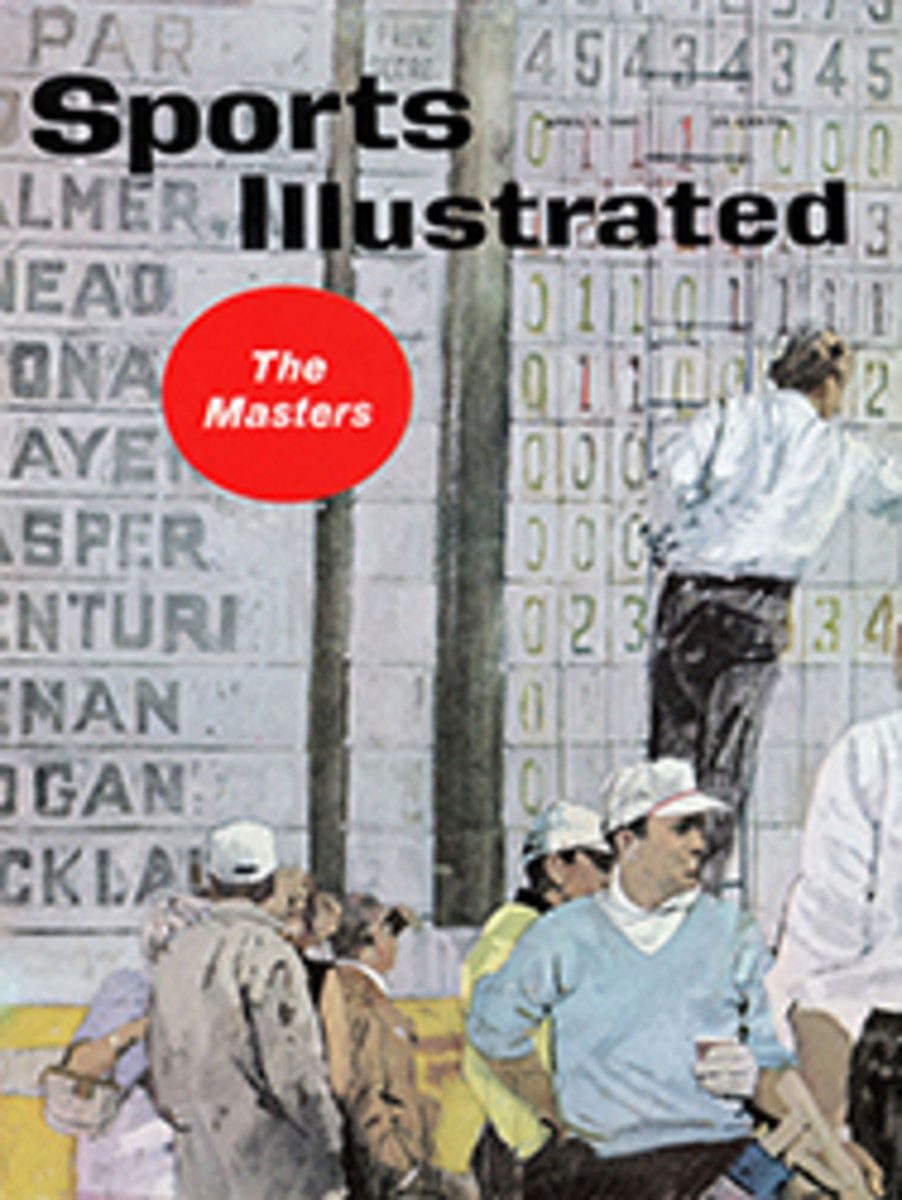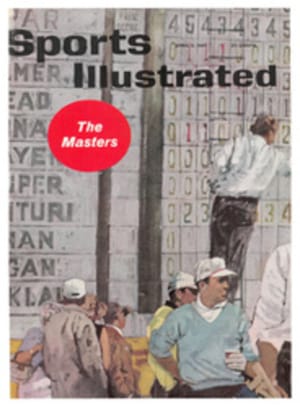
A REAL BARN-BURNER IN KANSAS CITY
When 504 basketball coaches arrived in Kansas City last week for their annual convention and the game's national championship they were not really surprised to learn that everything, as the song goes, was up to date. Gone was the lurid and lively Kansas City of the '20s and '30s when Tom Pendergast ran the town. Then gambling joints were conveniently located in the downtown business district, saloon doors didn't have locks because they never closed, and in nightclubs naked (that's right, naked) waitresses served the patrons their beer and spiced shrimp.
The Municipal Auditorium, where Cincinnati, Utah, St. Joseph's and "unbeatable" Ohio State were to play for the championship, was constructed in those days. With its massive walls and vaulted roof it contains the highest percentage of concrete of any building in the world. Tom Pendergast owned the Ready-Mixed Concrete Company.
The modern Kansas City, the coaches found, has been ventilated. Its citizens sedately boast of their art gallery and university, their symphony and their sirloins. Which makes it altogether fitting that the biggest thrill Kansas City had' to offer last Saturday night was not supplied by a spicy shrimp, but rather by the most memorable basketball double-header ever played in a national championship.
It began at 7 p.m., and by the time it ended nearly five hours later the 10,700 limp patrons in Tom's concrete vault not only had seen a consolation round first game that went to four overtimes, but had witnessed a nervy bunch of underdogs from Cincinnati outfight, outplay and eventually outscore that nonpareil of college teams, Ohio State.
The Ohio State team, as unemotional as a machine, came to Kansas City unbeaten in 31 consecutive games played over the past two years. Winner of last year's title, the Buckeyes' greatest strength was their composure. They always took the floor as if the thought of losing had never occurred to them.
In Jerry Lucas the team had the best basketball player of the era. When opponents attempted to double-or triple-team Lucas, Larry Siegfried, the captain, and Mel Nowell would shoot from outside where they averaged nearly 50% of their field-goal attempts. On defense Ohio State had John Havlicek, a onetime high school quarterback who was as smooth as Johnny Unitas and as tough as Bobby Layne. He always guarded the opposition's toughest man and usually stopped him cold.
The only exception to the Buckeyes' peaceful aplomb was Siegfried. "He's a bit of a role player," Ohio State Coach Fred Taylor has said. Siegfried often would wave his arms, telling the team what the defense was and moving men around. The team had already recognized the defense, but Siegfried was showing he was captain. When Lucas began putting inner soles in his shoes so did Siegfried. Lucas wore his sweat pants when introduced before a game. So did Siegfried. When Richie Hoyt, a forward, got a corset for an arthritic condition that hampered his movement, Siegfried asked for a special hip pad. But if Siegfried was a bit of an actor, he was also a superb basketball player.
Taylor, of course, was responsible for his team's workmanlike attitude. Only 34, he was named Coach of the Year last season and was given the honor again last week. A year of having every opponent point for his team had left him tired and tense, but had not marred the color of his speech. "A real barn-burner," he said when his team beat Louisville by a single point. He took his players back to Columbus for three days of furious and exhausting practice. "Now they're head hunting again," he reported Friday.
The first available head belonged to St. Joseph's, the team Ohio State played in the first semifinal game Friday night. A surprise champion in the East, St. Joseph's is a small school that had never before gone so far in the NCAA tournament. When it won at Charlotte its balding, insomniac coach, Jack Ramsay, forgot his limited budget and promised his team new basketball shoes for Kansas City. Then, carried away, he bought them all hats too. In the small dark hours of Friday morning he had a nightmare that he was standing on the bench shouting for time out, but nobody would stop the game. That's about the way it turned out against Ohio State Friday night. St. Joe played poorly, and the Buckeyes won 95-69.
Oscar brought no championship
A clue to what would happen in the finals came in the second game Friday night when Utah, the western champion, was harassed to distraction by Cincinnati's defense. This Cincinnati defense was the most intriguing and unexpected basketball development of the year. For the past two years the University of Cincinnati had expected to win a national championship with its one-man team, Oscar Robertson, only to fail in the semifinals each time. This season Ed Jucker, in his first year as head coach after seven years as an assistant, decided on a major change.
He junked the traditional run-and-shoot style of Cincinnati ball, replacing it with a controlled offense and a defense that would do credit to the Baltimore Colts. Instead of using one man he used five. The change took time. Cincinnati lost three of its first eight, one by 17 points to St. Louis. After that fiasco, alarmed Coach Jucker held a team meeting, said a prayer and told his players they could still win the Missouri Valley Conference if they got tough. Not even he thought about the NCAA championship. But after a loss to Bradley, Cincinnati got tough indeed, and won 20 straight.
The toughest Bearcat was Bob Wiesenhahn, 220 pounds of burly bruiser who averaged 10 rebounds a game. He got help from the even more noticeable Paul Hogue, a 6-foot-9 bespectacled tree trunk. The tailor who cut the gray flannel blazers that Cincinnati wears when traveling added a fourth button to Hogue's coat. Three didn't look right. Thanks to this pair, Cincinnati had only been outrebounded once this year. In addition, the team had Carl Bouldin and Tony Yates, whom one West Coast coach calls the finest pair of guards he has ever seen on the same team. Jucker was understandably delighted when his defense ruined Utah's famed fast break and produced an easy 82-67 win. After the game, the Cincinnati band, coeds and all, oompahed its way into the dressing room to highlight an enthusiastic celebration, complete with hugs, kisses, cheers and singing of the alma mater. "Just one more," roared the team.
By contrast, Ohio State's dressing room after the St. Joseph's game was as staid as a bankers' meeting. There was a quiet discussion of plays and strategy before the team walked back through the streets to the hotel. If these were head hunters, they were grinding their axes silently.
Saturday afternoon Fred Taylor gave Ohio State its scouting report on Cincinnati. "Much of their success is credited to their rebounding," he wrote in the report. "Hogue and Wiesenhahn particularly will bomb the offensive boards and will push and shove to get up over you. Hogue is a bit gay with his ability as a duke man [he got in two scuffles in the Utah game]. Make him foul." By game time, State, with no mean defense of its own, was a solid favorite.
Kansas City, which had scheduled Van Cliburn ("6 feet 4 and what a pair of hands," observed one coach) in an adjoining auditorium Friday night, came back with Rise Stevens on Saturday night, but the best show still was on the basketball court.
It took two and a half hours to play the quadruple overtime consolation game between St. Joseph's and Utah, with St. Joseph's winning, 127-120. The fans had barely settled down from that remarkable contest when the championship game began. In a very few minutes Cincinnati let everybody know that this game, too, would be a contest.
Lucas, at his impassive and exquisite best, was forced to play 15 feet from the basket to be effective. He kept the game close by hitting one-handers from there, but the rest of the Ohio State offense looked strained and slow. Plays failed as Cincinnati made use of a special strategy of switching defensive assignments before Ohio State could test a foe's weaknesses and traits. The Bearcats maintained reasonable control of the backboards, took only the exceedingly good shots and forced the game into a pattern they liked, that of a grudging defensive battle. At the half the score was 39-38, Ohio State.
Each team showed its nerve under pressure in the second half. With 11 minutes left to play, thanks to five baskets on jump shots by Bouldin ("best outside shooter," Taylor's scouting report had said), Cincinnati was ahead by six points. Ohio State stormed back to go ahead by five, only to lose the lead again before the regulation game ended 61-61. Cincinnati got quickly ahead in the overtime and didn't give Ohio an opportunity to get even. The final score was 70-65, and Cincinnati was the new national champion in a truly stunning upset.
It was a beautiful basketball game, played by both teams with the pure poise and aggressiveness that the sport demands at its finest. A champion had been beaten, but by no fluke. There would be no second-guessing or sour grapes because there was simply nothing to second-guess. Cincinnati had played its new style of basketball to perfection. It had run its offense with extreme care, making adjustments quickly in the face of changing Ohio State defenses. For example, when Bouldin made his five straight shots from outside, Siegfried was forced to stop helping guard Hogue and to concentrate on his own man, Bouldin. Bouldin didn't waste a shot finding out Siegfried was playing him closer. He began at once to pass the ball to the now more-open Hogue.
In a burst of early enthusiasm Cincinnati made four charging fouls, then didn't make another after it learned how closely the referees were watching for this violation. The Bearcats made only two other errors that cost them possession of the ball before they could shoot, compared to Ohio State's 11. Though the Cincinnati defense couldn't stop Lucas from getting 27 points, it forced the normally fast Buckeye offense to become fatally cautious. Ohio State averaged only a shot a minute through the second half and the overtime.
The trophies were awarded immediately after the game, and the Ohio State players, unaccustomed to defeat, mirrored their personalities with their reactions. Calm, gentlemanly Jerry Lucas, with another season yet to play, quickly smothered a half scowl with smiles of congratulations for the winners. And battler Larry Siegfried, the huge second-place trophy clutched dismally to his chest, threw a towel over his head to hide himself from the crowd, and cried.
At the same time, the Cincinnati team screamed, howled, pranced and danced as it received its trophy. It had every reason and right to do so. To borrow a phrase from Fred Taylor, the Bearcats had not only beaten the best, they had done it in a barn-burner.
PHOTO
NEIL LEIFER
LOSER'S TEARS are concealed under towel by Ohio State Captain Larry Siegfried.
PHOTO
NEIL LEIFER
WINNERS' SMILES are flashed by Coach Jucker, Players Thacker and Wiesenhahn.
PHOTO
NEIL LEIFER
CINCINNATI STRATEGY IN ACTION: OSU'S LUCAS (11), KEPT OUTSIDE, IS CONCEDED SHOOTING ROOM BY HOGUE (GLASSES) WHO FOULS WHEN GUARDING CLOSELY

